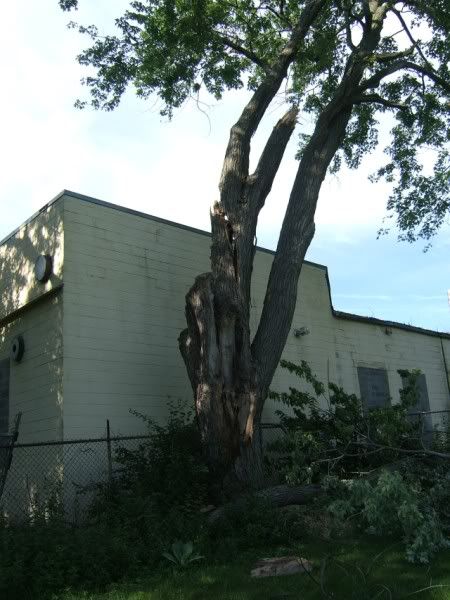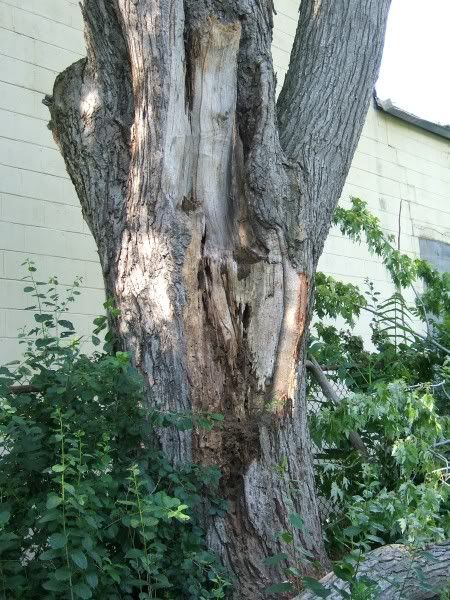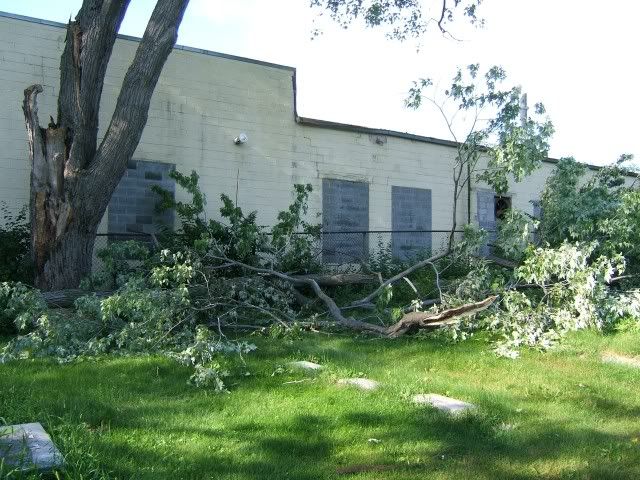Clean up the area around the base of the tree. You need an escape route in clean shape.
Around the split, wrap a rope 5-7 times and tie it into itself. At the first good limb on the split spar, use a throw line, wrap a rope around the tree and pull it up tight gingerly. Take other end over to the good spar and wrap it around the good spar at about the same height once, then off to the truck or winch. You are going to cut this as if it were in good shape and drop the whole tree at one time.
I would use a ladder to stand on to tie the split together.
Put as little weight on the split spar as you can until you tie the split together. Make sure you have cleaned up your exit route before you begin to cut. You have a mess laying around at the bottom of that tree get it out of there before you start, that includes knocking down the weeds.
Get your signals down with the ground guys, what and how you want the guys on the pulling end of the rope to work.
Cut a shallow facecut about two feet off the ground facing the way you want the tree to fall, you may or may not want to plunge the face. Plunge cut directly in the back of the tree towards the face to get an idea of how good the holding wood is going to be for the backcut. Cut the backcut on the building side first and then on the escape route side last.
If the tree is hollow, nibble a little at a time off the left side of the backcut then a litte off the right side. Repeat until the tree starts to move then signal the ground guys to pull it over.
The reason you tie rope/pull line around the split spar then over to and wrap once around the good spar is so as you tighten up on the rope the bad spar is pulled into the good spar as the tree goes over.
Leave very little hinge because you want this to go over as if it were one tree and not two spars. It has a pronounced lean and you can't pull hard without breaking the tree apart. Use a light hinge.
I would use 3/4" rope, a chain or cable to tie/wrap the split and 5/8" or better to pull the tree over. The idea is to have enough good wood for the hinge to work while not having to load the split spar too much causing it to break loose while pulling the tree over.
Be prepared, the split spar will move but it should not break loose/snap the rope if you wrap it 5-7 time around the split.
When you make the face cut you might want to plunge cut into the facecut to see how much good wood there is to base your hinge on.
A plunge in the center of the facecut should not hurt your hinges chacteristics but it will tell you how much wood you can count on when you make the hinge. If you are concerned about loading the split spar too much with the pull line, wrap the line/rope around the good spar twice or more before running the end of the rope to the winch or truck. The friction caused by the extra wraps will load the good spar first (heavy load and split spar less).
A couple of suggestions,
take a change of clothes. When the split spar moves but doesn't break loose
you might need to change the undies.

Gently tighten up the pull line. You want it tight (tree still standing) but you don't want to prematurely pull the tree over (catostropic failure), you want the hinge to do it's job and work. These usually fall like a normal tree once you tie them up. You really need to do the plunge cut to see how much wood you have to work with. If you are spooked by there not being a lot of good wood to work with leave a strap of wood on the back of the tree and cut it last. When you do this, cut the strap below the backcut 2"-3" if you want the tree to go over slowly.
Do not cut the strap above the backcut as this sometimes pinches the bar/chain and takes the saw out of your hands as it goes over.
If the tree is hollow, cut your facecut as if it weren't. Then behind the facecut about 4"-5" plunge in one side and cut towards the back leaving 4" of wood in the back. Step around to the other side and start from 4"-5" behind the face and cut toward the back leaving wood in the back. Have the guys tighten up the slack in the pull line and then cut the back loose and over it goes.
These aren't hard to do they are just spooky, they make these breaking wood noises that cause the faint of heart to load their pants. :hmm3grin2orange:












